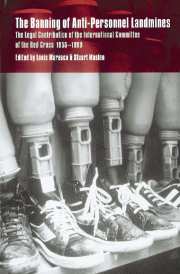 The Banning of Anti-Personnel Landmines
The Banning of Anti-Personnel Landmines Book contents
- Frontmatter
- Contents
- Foreword by Cornelio Sommaruga, President, International Committee of the Red Cross
- Foreword by Ambassador Jacob S. Selebi, South Africa
- Foreword by Ambassador Johan Molander, Sweden
- Introduction
- PART 1 FROM PRINCIPLES TO RULES: REGULATING MINES UP TO THE 1980 CONVENTION ON CERTAIN CONVENTIONAL WEAPONS
- PART 2 THE REVIEW CONFERENCE OF THE 1980 CONVENTION ON CERTAIN CONVENTIONAL WEAPONS: AN INITIAL RESPONSE TO THE LANDMINE CRISIS
- PART 3 THE OTTAWA PROCESS FROM REGIONAL INITIATIVES TO AN INTERNATIONAL PROHIBITION OF ANTI-PERSONNEL MINES
- Index
Foreword by Cornelio Sommaruga, President, International Committee of the Red Cross
Published online by Cambridge University Press: 03 December 2009
- Frontmatter
- Contents
- Foreword by Cornelio Sommaruga, President, International Committee of the Red Cross
- Foreword by Ambassador Jacob S. Selebi, South Africa
- Foreword by Ambassador Johan Molander, Sweden
- Introduction
- PART 1 FROM PRINCIPLES TO RULES: REGULATING MINES UP TO THE 1980 CONVENTION ON CERTAIN CONVENTIONAL WEAPONS
- PART 2 THE REVIEW CONFERENCE OF THE 1980 CONVENTION ON CERTAIN CONVENTIONAL WEAPONS: AN INITIAL RESPONSE TO THE LANDMINE CRISIS
- PART 3 THE OTTAWA PROCESS FROM REGIONAL INITIATIVES TO AN INTERNATIONAL PROHIBITION OF ANTI-PERSONNEL MINES
- Index
Summary
The signing by 123 States of the Convention on the Prohibition of Antipersonnel Landmines (Ottawa treaty) in December 1997 was the culmination of lengthy efforts to lay down international rules against the use of anti-personnel mines. Only nineteen months earlier many in the international community had been disappointed by the failure of the 1995–1996 Conference reviewing the 1980 Convention on Certain Conventional Weapons to take decisive action against anti-personnel mines. Rather than consider the issue closed, governments and civil society continued to push for the comprehensive ban they felt was essential to halt the carnage caused by this weapon. By late 1997, some fifty governments had committed themselves to the treaty. When the signing ceremony was held this number had more than doubled and it took only ten months to attain the forty ratifications needed to bring the treaty into force. This was the fastest-ever entry into force of a multilateral arms-related agreement.
Bringing about a ban on anti-personnel mines was truly a remarkable achievement. Never before had such a diverse group of governments, organizations and UN agencies come together to put an end to a crisis of this type; never before had so many people around the world felt compelled to voice their outrage at the effects of a weapon designed to strike indiscriminately at soldiers and civilians alike. This had been a unique alliance between civil society and governments to bring into existence a treaty of international humanitarian law. The process involved was a true manifestation of what humanitarian law describes as ‘the dictates of public conscience’ and showed how that concept can change the world.
- Type
- Chapter
- Information
- The Banning of Anti-Personnel LandminesThe Legal Contribution of the International Committee of the Red Cross 1955–1999, pp. xvii - xxPublisher: Cambridge University PressPrint publication year: 2000


